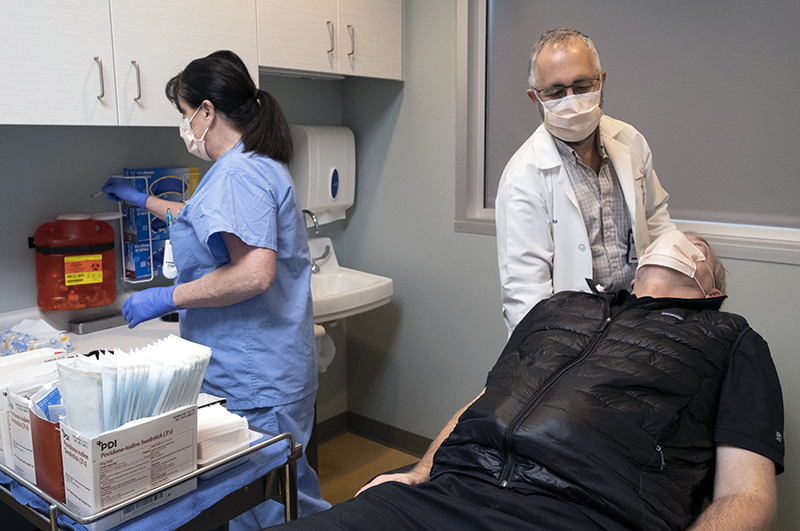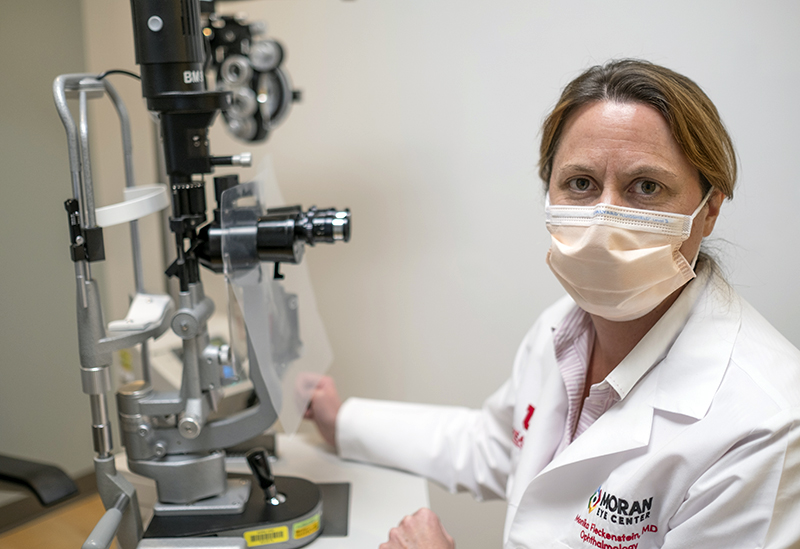Breadcrumb

Every four weeks for the past decade, 80-year-old Kay Lipman has traveled from her home in Ogden to Salt Lake City’s John A. Moran Eye Center to receive sight-preserving injections for her age-related macular degeneration (AMD).
When the COVID-19 pandemic hit, Lipman was worried. She was at a higher risk for COVID-19 due to her age, but she also knew AMD could rapidly blind her if left unchecked. Would her treatments be interrupted, she wondered? If not, what types of safety precautions would the clinic be taking?
Her questions echoed those of millions of people nationwide facing progressive vision loss due to AMD, diabetic retinopathy, glaucoma, and other conditions requiring ongoing treatments. While the pandemic temporarily halted routine exams and surgeries for several weeks, Moran Eye Center physicians let patients like Lipman know they were ready to continue providing essential, urgent treatments—with extra precautions to keep everyone safe from infection.
"By restricting the number of patients and staff in the building at one time and by screening everyone for symptoms of COVID-19, including taking staff and patient temperatures, we’ve been able to provide uninterrupted care for these patients and meet urgent eye care need."
Norm Zabriskie, MD, Moran’s director of clinical operations
Sight-Saving Treatments in an Uncertain Time

The most common cause of vision loss in people over 55, AMD can take away central vision and the ability to see color and fine detail when looking directly at an object. Researchers have yet to find a cure, but treatments to slow the progression of vision loss have helped Lipman maintain as much precious vision as possible.
During the COVID-19 pandemic, she and her specialist, Paul S. Bernstein, MD, PhD, are staying on track.
"I’ve been giving Kay monthly injections in both eyes for AMD for more than ten years," said Bernstein. "If she were to go too long between visits, her vision would deteriorate. Recently, she has also been receiving chemotherapy at the Huntsman Cancer Institute, so we now have very narrow windows when we can safely give her injections. We are fortunate to still be able to provide timely injections to preserve her visual acuity."
Lipman’s first treatment during the COVID-19 crisis reassured her concerns about safety.
"Dr. Bernstein was scheduled at Moran’s Midvalley location the day I had my first injection since COVID," said Lipman. "At first, I was a little worried about going into the clinic. My son drove me from Ogden and was asked to wait in the car. At the reception desk, they took my temperature, asked me some questions, and then I was the only person in the waiting room. It felt very safe. I call Dr. Bernstein a ‘quiet hero.’ We have become friends after all these years, and he is up-to-date on everything—from all things medical to my family news."
Helping New AMD Patients in Need

Essential care during COVID-19 was particularly crucial for patients like
Kathleen Rice, 80, who was diagnosed with early signs of AMD two years ago. Rice started taking a specially formulated combination of vision-protecting vitamins called AREDS supplements. She also monitored her vision with a simple printed graphic called the Amsler Grid—a method for testing your eyes at home every day to detect any changes.
Rice’s vision remained stable until right before the COVID-19 restrictions when she began noticing that straight lines appeared wavy—one early, critical symptom of AMD. Rice immediately contacted Moran to see Monika Fleckenstein, MD.
"I was nervous about the change in my vision," said Rice. "The first time I met Dr. Fleckenstein, we were able to shake hands and get to know one another. The second time, during the COVID shutdown, I was a little hesitant about going into Moran. But all the appropriate restrictions were in place, and Dr. Fleckenstein wore a mask. She was quick and businesslike, and I appreciated that."
Fleckenstein took immediate action and scheduled a full treatment regimen.
"Kathleen had wet AMD with a hemorrhage in her left eye. We started therapy in February. At the beginning of the treatment, four months of injections are necessary to achieve a response—at least stabilization or improvement," explained Fleckenstein. "If we stop the ‘upload phase’ of three injections—one every four weeks—the therapeutic effect is likely to get lost and there is a high risk of further vision loss."
Going the Distance for AMD Treatments

Lanny McLean, 86, drives five hours from his Sun Valley, Idaho home to Moran’s University location every six to eight weeks to see Mary Elizabeth Hartnett, MD.
"Lanny has bilateral AMD and needs injections in both eyes. Right now, his central vision in one eye is poor, but to preserve vision in both eyes, it is important for him to come in for imaging and regular injections," said Hartnett.
As much as he relies on his regular treatments, McLean had reservations about his most recent visit.
"As far as the COVID-19 precautions, I was extremely concerned about going to Salt Lake and getting a hotel room. I live in Blaine County, one of the country’s hot spots," said McLean. "But everything worked out. My experience was perfect—people were masked, it was all properly done. As for Dr. Hartnett, if you ask me, on a scale of one to 10, she is a 20. I am convinced she has saved my eyesight."
Zabriskie said he and his fellow ophthalmologists understand the importance of sight-saving emergency care for those who need it.
"Our top priority is keeping every patient, physician, and staff member as safe and healthy as possible, every day," said Zabriskie. "We know a loss in vision can have significant consequences. Everyone in the Moran organization has stepped up to meet the extra challenges presented by COVID-19, and we remain committed to carrying out all safety procedures as long as necessary."